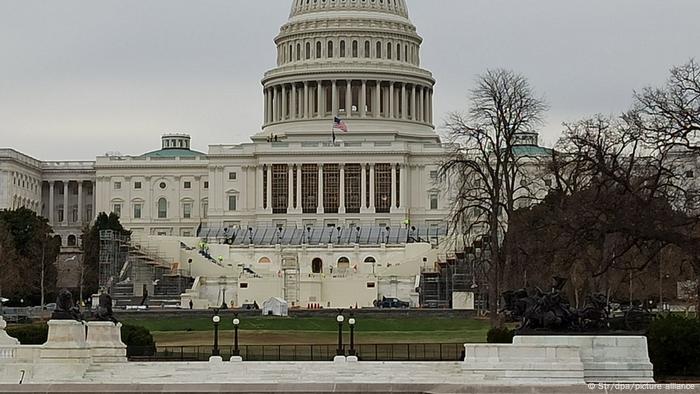The extinct giant canids were a remarkable example of convergent evolution
By Riley Black on January 13, 2021
 Somewhere in Southwestern North America during the late Pleistocene, a pack of dire wolves (Canis dirus) are feeding on their bison kill, while a pair of grey wolves (Canis lupus) approach in the hopes of scavenging. One of the dire wolves rushes in to confront the grey wolves, and their confrontation allows a comparison of the bigger, larger-headed and reddish-brown dire wolf with its smaller, grey relative. Credit: Mauricio Antón
Somewhere in Southwestern North America during the late Pleistocene, a pack of dire wolves (Canis dirus) are feeding on their bison kill, while a pair of grey wolves (Canis lupus) approach in the hopes of scavenging. One of the dire wolves rushes in to confront the grey wolves, and their confrontation allows a comparison of the bigger, larger-headed and reddish-brown dire wolf with its smaller, grey relative. Credit: Mauricio Antón Dire wolves are iconic beasts. Thousands of these extinct Pleistocene carnivores have been recovered from the La Brea Tar Pits in Los Angeles. And the massive canids have even received some time in the spotlight thanks to the television series Game of Thrones. But a new study of dire wolf genetics has startled paleontologists: it found that these animals were not wolves at all, but rather the last of a dog lineage that evolved in North America.
Ever since they were first described in the 1850s, dire wolves have captured modern humans’ imagination. Their remains have been found throughout much of the Americas, from Idaho to Bolivia. The La Brea asphalt seeps famously document how prey animals mired in tar lured many of these ice age predators to a sticky death. The dire wolves’ tar-preserved remains reveal an imposing hunter up to six feet long, with skull and jaw adaptations to take down enormous, struggling megafauna. Though these canids had clearly evolved to handle the mastodons, horses, bison and other large herbivores then roaming the Americas, skeletal resemblances between dire wolves and the smaller gray wolves of today suggested a close kinship. It had long been assumed that dire wolves made themselves at home in North America before gray wolves followed them across the Bering Land Bridge from Eurasia. Now some well-preserved DNA seems to be fundamentally changing the story.
The new study, published on Wednesday in Nature, began as an effort to understand dire wolves’ biological basics. “For me, it started with a decision to road-trip around the U.S. collecting dire wolf samples and see what we could get, since no one had managed to get DNA out of dire wolf samples at that point,” says Durham University archaeologist and study co-author Angela Perri. At the same time, geneticist and co-author Kieren Mitchell of the University of Adelaide in Australia was also trying to extract and study ancient DNA from dire wolf remains—as were other labs that eventually collaborated on the project.
One of the researchers’ questions was how dire wolves were related to other wolves. For decades, paleontologists have remarked on how similar the bones of dire wolves and gray wolves are. Sometimes it is difficult to tell them apart. “My hunch was that dire wolves were possibly a specialized lineage or subspecies of gray wolf,” Mitchell says.
But the new evidence told a different story. Preliminary genetic analyses indicated that dire and gray wolves were not close relatives. “I think I can speak for the whole group when I say the results were definitely a surprise,” Perri says.
After sequencing five genomes from dire wolf fossils between 50,000 and 13,000 years old, the researchers found that the animals belonged to a much older lineage of dogs. Dire wolves, it now appeared, had evolved in the Americas and had no close kinship with the gray wolves from Eurasia; the last time gray wolves and dire wolves shared a common ancestor was about 5.7 million years ago. The strong resemblance between the two, the researchers say, is a case of convergent evolution, whereby different species develop similar adaptations—or even appearances—thanks to a similar way of life. Sometimes such convergence is only rough, such as both birds and bats evolving wings despite their differing anatomy. In the case of dire and gray wolves, lives of chasing large herbivores to catch some meat on the hoof resulted in two different canid lineages independently producing wolflike forms.
“These results totally shake up the idea that dire wolves were just bigger cousins of gray wolves,” says Yukon paleontologist Grant Zazula, who was not involved in the new study. In fact, the similarity between the two has led gray wolves to be taken as proxies for dire wolf biology and behavior, from pack dynamics to the sound of the animal’s howls. The dire wolf’s new identity means that many previous assumptions—down to what it looked like in life—require reinvestigation. “The study of ancient DNA and proteins from fossil bones is rapidly rewriting the ice age and more recent history of North America’s mammals,” Zazula says.
In technical terms, the new findings mean dire wolves may need a new genus name to indicate they are no longer be part of the genus Canis, to which gray wolves belong. Perri, Mitchell and their colleagues suggest Aenocyon, meaning “terrible wolf.” But the researchers don’t expect their findings to completely overturn tradition, and Aenocyon dirus would likely continue to be called the dire wolf. “They will just join the club of things like maned wolves that are called wolves but aren’t really,” Perri says.
The new findings also add layers to experts’ ruminations on why dire wolves eventually disappeared as the last ice age closed. These predators became specialized in hunting camels, horses, bison and other herbivores in North America over millions of years. As those prey sources disappeared, so did the dire wolves. “In contrast to gray wolves, which are a model for adaptation,” Perri says, “dire wolves appear to be much less flexible to deal with changing environments and prey.”
Nor did dire wolves leave a genetic legacy beyond the decaying DNA in their ancient bones. Although canids such as wolves and coyotes often create hybrids, dire wolves apparently did not do so with any other canids that remain alive today. Perri, Mitchell and their colleagues found no DNA evidence of interbreeding between dire wolves and gray wolves or coyotes. Dire wolves were genetically isolated from other canids, Mitchell notes, so “hybridization couldn’t provide a way out” because dire wolves were probably unable to produce viable offspring with the recently arrived wolves from Eurasia.
By 13,000 years ago, dire wolves were facing extinction. Evolving in the harsh, variable environments of Eurasia may have given gray wolves an edge, Zazula notes, “while the big, bad dire wolves got caught off guard relaxing in southern California at the end of the ice age.” But what might sound like the end of the dire wolf’s story is really only the beginning. Preserved genes have shown that dire wolves and their ancestors were top dogs in the Americas for more than five million years—and the early chapters of their story are waiting to be rewritten.
ABOUT THE AUTHOR
Riley Black, who formerly wrote under the name Brian Switek, is the author of Skeleton Keys and My Beloved Brontosaurus. She lives in Salt Lake City, Utah. Follow her on Twitter and Instagram.







 Article 196 of Poland's criminal code prohibits offending religious sentiment Wojtek RADWANSKI AFP/File
Article 196 of Poland's criminal code prohibits offending religious sentiment Wojtek RADWANSKI AFP/File

